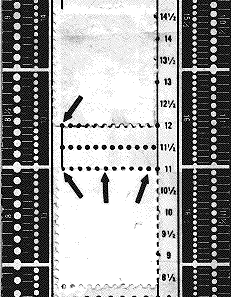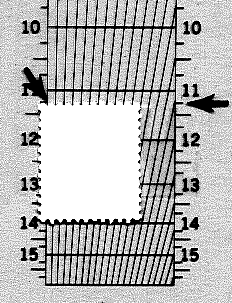In the beginning there were stamps, and these stamps were imperforate and had to be cut apart with scissors. They were not then called imperforate; they were just called stamps. Soon someone thought of perforations; and low and behold, they were now easy to separate. But there was found to be no gum and...
Perforations are there to make separating the stamps easy. The more holes per inch, the easier the stamps separate. However, the PO doesn't want the stamps falling apart when they are handled. The result of these two somewhat conflicting requirements is the reason that some issues have many different perforations. The PO's in many countries experimented with many different gauges (number of holes per inch) until they found ones that worked with the types of paper they were using to print stamps on.
Perforations are one way we, as collectors, classify different issues of the same stamp. Measuring perforations are one of the easier things to deal with when learning to collect. Perforations come in three basic types. There is the classic perforation where paper has been removed creating a line of holes to ease the separation of the stamps. The roulette is a form of perforation where no paper has been removed (just a line of little cuts). The last form of perforation is the pin-hole or sewing-machine perforation (here again, no paper has been removed). Most perforations are of the classic, round-hole variety with paper removed.
There is one form of perforation where the holes are rectanglar and paper is removed. These are properly called hyphen-hole perforations, although they are often called hyphen-hole roulettes (this is incorrect because paper was removed). These perforations are a line of little rectangles. When you have two stamps attached to each other, the rectangles are very clearly different from a hyphen roulette, which is just a series of dash-shaped cuts. Hyphen-hole perforations are fairly uncommon. They are found on some US Revenues (the battleship documentaries for example), some state revenues, and on some foreign stamps and revenues. For most collectors, the only time you will have any problems with separating the hyphen-hole perforation from the hyphen roulette is if you collect US revenues.
Pin perforations are also uncommon. They are found on some state revenues and on some foreign stamps. They look like a string of little pin pricks, which is what they are. Pin perforations are uncommon because they don't do a great job of making the stamps easier to separate.
Roulettes come in many shapes. The pictures in the front part of any Scott catalog pretty well show the differences. The most common roulette is the hyphen roulette, which, as mentioned before, is just a line of dash-shaped cuts. Roulettes don't work as well as regular perforations do, but they are cheaper to apply. The roulettes are just added to the paper in a printing press using sections of knife-like printing bars. In fact, the roulettes can be applied at the same time as the stamps are printed (the knives are set between the stamp cliches in the plate), and this results in colored roulettes as found on some stamps from the German states.
Regular perforations come in two types: line and comb. Line perforations are made by running the sheets of stamps through the perforator first in one direction and then at 90��. This results in the perforation holes not being in the same place at the corners of the stamps. Comb perforations result when the perforations in both directions are applied at the same time. This results in a perforation hole at each corner. These differences are usually only important to the specialist or advanced collector. The only times that I have messed with these differences is with the buildings issue from Germany (circa 1948) and with the 13-cent Americana stamp. I am sure there may be others.
Perforations are measured by counting the number of holes per two centimeters. This would be a very tedious project if we had to count them for each stamp. Fortunately, we have a tool to do this job; and surprisingly, it is called a perforation gauge. Gauges come in two types. Both types are based on the assumption that the holes are evenly spaced (rarely they are not). The first type are the ones you usually get free and they are the ones with little black spots. To use this first type, you just start at one side and move the stamp up and down until the spots fill all the holes. The second type of perforation gauge you usually have to buy and has lines that move from close together to further apart as one goes from one end to the other. These gauges are usually more accurate, but they require a little more skill to use. You just line up the left vertical line with the middle of the left perforation, and then you move the gauge up or down until all the lines are centered in perforation holes (always check the one in the center last). You read the perforation gauge value off either side at the point where the lines all line up with the holes. Like everything else, play with your gauge until you get it right. If you have problems, have someone show you. The first type gauge (dot type) (see below for image) usually comes on cardboard. They are also found on metal, but those you usually have to buy. My favorite of this last type is called a Herringbone because the dots are on diagonals, which allows you to measure the perforations of mounted stamps easier than with any other kind of gauge. Mine is about worn out, and I don't think they are made anymore. If you can find one, treasure it. The second type of gauge (line type) (see image below) is printed on plastic. The plastic sometimes shrinks with age, so it is important to check these gauges with a known perforation every ten years or so.
Comb perforations tend to be the same on all four sides, but not always. Line perforations tend to have one value for the horizontal perforations (top and bottom) and another value for the vertical perforations on the sides. There are some stamps known with different perforations on all four sides (the scenes issue from Bosnia for one). Check your catalog to see what you are looking for before you start to measure. Usually the weird perforations are only listed in specialized catalogs.
Measuring roulettes and hyphen-hole perforations require that you use a line-type gauge, although you can make a good guess with the dot type. The important thing to remember when measuring these types is to put the line at the same place with each perforation. That is, if you measure from the middle of the first perforation then you put the lines in the middle of all the other perforations.
If you see an entry in the catalog that says the stamp is perf 13, this means all four sides are perf 13. If the entry says it is 11 x 13, then the horizontal perforations are perf 11 and the vertical perforations are perf 13. The horizontal measurement comes first. If it says the stamps are perf 13 to 16 by 10 to 12, this means you had better get a specialized catalog if you're going to worry about these stamps. It also means that this group of stamps is different from the other groups listed with different perfs or ranges of perfs.
If the catalog says the perforations are irregular, it means just that; and unless you really want to get into something, move on. Irregular perforations, fortunately, are fairly uncommon.
Dots

Lines
